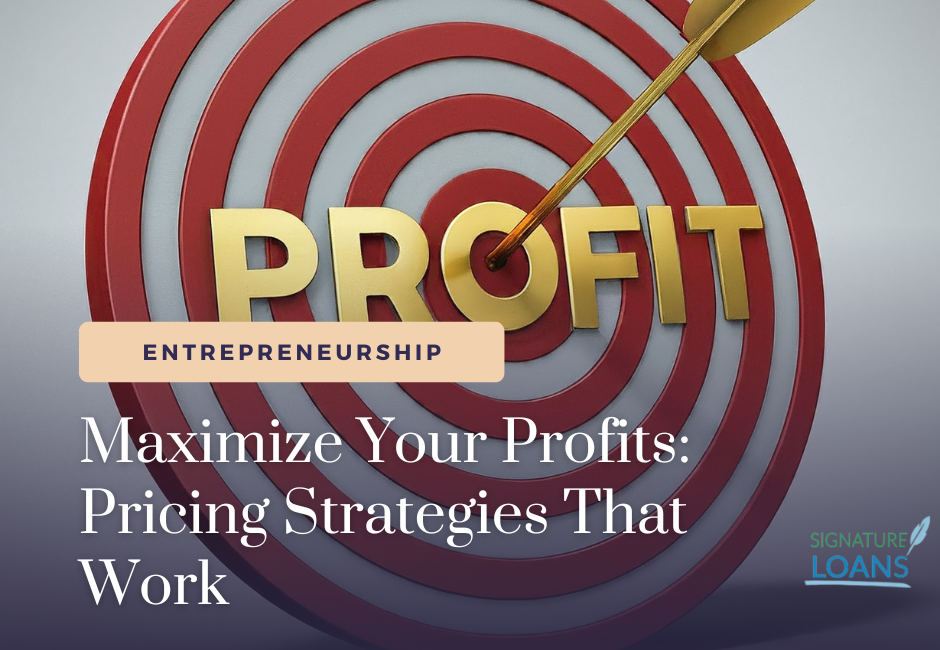Table of Contents
Complimentary Video
Introduction
To maximize your profits in today’s fast-paced and highly competitive market, determining the right pricing strategies can make or break a business.
Pricing isn’t just about covering costs or staying competitive; it’s a powerful lever for maximizing profits. In fact, the right pricing approach can significantly enhance revenue without changing any other aspect of your product or service. But how do you craft a pricing strategy that truly works? How can you set prices that not only attract customers but also maximize your profits?
Pricing isn’t just about numbers; it’s about psychology, market dynamics, and delivering perceived value to your customers.
This article explores some of the most effective pricing strategies that work across various industries, helping you optimize your price points to boost profitability.

Understanding the Basics of Pricing
Why does pricing matter so much? The price of a product or service is often the first thing customers notice. It instantly communicates value, quality, and even status. A well-thought-out pricing strategy takes into account not only your costs but also what your target customers are willing to pay.
Pricing isn’t static. A successful business frequently revisits and adjusts its pricing model based on market conditions, competitor actions, and customer expectations.
A strong pricing strategy is a crucial tool for profitability and growth.
Factors Influencing Pricing
To determine a profitable price point, several factors need to be considered. These include:
- Demand: Is there strong demand for your product? Higher demand often allows for premium pricing.
- Competition: What are your competitors charging? If your price is significantly higher, you’ll need a strong value proposition to justify the difference.
- Cost: Your costs are the minimum you need to cover to avoid losses. However, simply covering costs doesn’t maximize profitability.
Understanding these influences helps you create a dynamic and flexible pricing strategy that can adapt to different circumstances, ensuring long-term profitability.
Maximize Profits with Value-Based Pricing
One of the most powerful pricing models for profit maximization is value-based pricing. Unlike cost-plus pricing, where a percentage is added to the cost of the product, value-based pricing focuses on the perceived value to the customer.
The goal is to set a price that reflects the benefits and value your product provides rather than just its production cost.
This strategy works well when your product or service offers unique features, high-quality materials, or a brand reputation that customers are willing to pay more for.
Think of premium brands like Apple or luxury fashion houses—these companies successfully implement value-based pricing by charging a premium for the perceived higher value they offer.
Benefits of Value-Based Pricing
The primary benefit of value-based pricing, among other pricing strategies, is that it aligns your price with what the market is willing to pay. This allows you to capture more consumer surplus—the extra amount consumers are willing to pay beyond the actual cost.
Another key advantage of value-based pricing strategies is that it encourages you to innovate and differentiate your products. Since you’re pricing based on value rather than cost, you’ll focus more on creating a product or service that stands out in the market.
Cost-Plus Pricing Strategy
Cost-plus pricing, one of the oldest and simplest methods, involves calculating your total production cost and adding a fixed percentage as profit.
For example, if it costs $50 to produce an item, and you want to add a 20% profit margin, you would price the item at $60.
While this method is straightforward, it doesn’t always consider market dynamics or customer willingness to pay, which can hinder your ability to maximize your profits.
Is Cost-Plus Pricing Still Effective?
Cost-plus pricing is best suited for industries with stable costs and little competition. However, it’s less effective in highly competitive markets or industries where customer perception drives sales.
The main downside is that it ignores customer willingness to pay and market demand, which can lead to prices that are either too high or too low.

Psychological Pricing Techniques
Pricing is as much about psychology as it is about mathematics.
By understanding how customers think and behave, you can craft effective pricing strategies that “feel” right, encouraging them to purchase.
The Power of Charm Pricing
Charm pricing is the practice of ending prices in odd numbers like 9 or 7. For example, setting a price at $9.99 instead of $10.
This strategy works because customers perceive the price to be significantly lower, even though the difference is just one cent. It’s a simple, time-tested method that can help maximize your profits and make a big difference in sales.
Using Price Anchoring to Drive Sales
Price anchoring is another psychological pricing technique where customers are presented with an initial high price, followed by a lower price. The first price serves as a reference point (or anchor), making the second price appear more attractive. This technique is commonly used in sales and promotions and can significantly boost conversions.
Dynamic Pricing Strategy
Dynamic pricing is a flexible approach where prices fluctuate based on real-time demand, market conditions, and competitor pricing. This strategy is often used in industries like travel, hospitality, and e-commerce.
For instance, airlines regularly adjust ticket prices based on seat availability, time of booking, and seasonal demand.
Benefits of Dynamic Pricing for Profit Maximization
Dynamic pricing empowers businesses to capitalize on peak demand, optimizing revenue.
When demand is high, prices can increase, leading to higher margins. Conversely, during slow periods, lower prices can attract more customers, helping to maintain cash flow.
This strategy also helps businesses stay competitive by responding to market changes quickly. However, it requires careful monitoring and data analytics to avoid alienating customers with erratic price shifts, which could negatively impact your ability to maximize your profits in the long run.
Penetration Pricing Strategy
Penetration pricing involves setting a low price to enter a competitive market and attract customers quickly.
The goal is to build market share by offering an attractive price that undercuts competitors.
Once a strong customer base is established, businesses can gradually increase their prices.
Long-Term Benefits of Penetration Pricing
While penetration pricing may reduce profits in the short term, it can lead to long-term success by establishing a loyal customer base.
This strategy works well for new entrants in saturated markets, especially when combined with a high-quality product offering.
Shifting to premium pricing after capturing market share allows businesses to improve profitability without losing the trust of their customer base.
Skimming Pricing Strategy
Skimming pricing is the opposite of penetration pricing. It involves setting high prices during the initial product launch to capitalize on early adopters who are willing to pay a premium for the latest innovation. Over time, the price is gradually lowered to attract more price-sensitive customers.
How Skimming Works for Product Launches
Skimming works best for new, innovative products that have little competition at launch. It allows businesses to recoup their investment quickly and capitalize on the “novelty factor.” Once the initial excitement wears off, the business can lower the price to appeal to a broader market.
This strategy is often seen in the technology sector, particularly with new gadgets or smartphones. Companies like Apple often use skimming pricing to capture early adopters at a premium price before lowering the price to target the mass market.
Competitive Pricing Strategy
In highly competitive industries, businesses often adopt competitive pricing, where they set their prices based on what competitors are charging.
While this strategy can be effective in attracting customers, it can limit the potential to maximize your profits.
This is especially common in industries with little differentiation, such as gasoline or consumer electronics.
Matching vs. Beating Competitor Prices
Competitive pricing can either involve matching competitor prices or slightly undercutting them.
However, a race to the bottom can erode profits, so it’s crucial to differentiate your offering or provide additional value to avoid competing solely on price.
Freemium Pricing Strategy
One of the most popular pricing models in the digital world is the freemium pricing strategy, which combines free and premium offerings. It allows businesses to attract a large base of users by offering a core product for free while monetizing through premium features, subscriptions, or add-ons.
Freemium is widely used in software, apps, and online services, where offering a basic version for free helps build brand loyalty and attract a broad audience.
Attracting Users with a Freemium Model
Freemium pricing works on the principle that people love free products, but many are willing to pay for additional value or advanced features.
By offering a free version, companies reduce the barriers to entry and quickly grow their user base, which ultimately can help maximize your profits.
However, the key to success lies in crafting a premium offering that is compelling enough for a subset of users to upgrade and pay.
For example, services like Spotify and LinkedIn offer free accounts with limited functionality, encouraging users to switch to premium versions for added benefits like ad-free experiences, exclusive content, or more storage.
Converting Freemium Users into Paying Customers
The freemium model focuses heavily on converting free users into paying customers. To do this effectively, companies must highlight the benefits of the paid version at strategic touchpoints, such as when users hit usage limits or encounter a need for advanced features. This method creates a natural progression from free to paid, without the user feeling pressured.
Providing excellent customer service, offering time-limited discounts, or giving trial access to premium features can also encourage users to make the leap from freemium to paid plans.
Many SaaS (Software as a Service) businesses have mastered this model, using clever nudges and personalized communication to drive conversions.
Case Studies of Successful Freemium Models
Dropbox, Slack, and Zoom are some of the biggest names that have thrived using freemium pricing.
Dropbox, for instance, offers a free plan with limited storage but tempts users to upgrade for more space.
Zoom’s free version became wildly popular during the pandemic, but the limitations on meeting length pushed many users to opt for premium packages.
Freemium pricing can be highly lucrative when designed to balance free offerings with an appealing upgrade path, providing users a taste of what they could experience by subscribing to the premium plan.
Subscription-Based Pricing
In the era of recurring revenue models, subscription-based pricing has become a go-to strategy for companies looking to create consistent cash flow and long-term customer relationships.
Subscription pricing allows customers to pay a recurring fee (weekly, monthly, or yearly) to access a product or service over a continuous period.
Building Recurring Revenue Streams
Subscription models, such as those offered by Netflix, Adobe, and Amazon, provide businesses with predictable and consistent income streams. This financial stability helps companies plan better and focus on enhancing their offerings.
For consumers, subscriptions reduce the burden of a large upfront cost while providing access to continuous service.
Subscription pricing has also made its way into industries like food, fashion, and education, where meal kits, fashion boxes, and online learning platforms have flourished using this model.
Why Subscriptions Maximize Customer Lifetime Value
Subscription models are particularly effective at maximizing customer lifetime value (CLV), which directly contributes to maximizing your profits.
By maintaining an ongoing relationship with customers, businesses can generate more revenue over time compared to one-off sales. Additionally, fostering customer loyalty can lead to positive word-of-mouth marketing, where satisfied customers get referrals from customers and bring in new business.
However, the key to subscription success is retention. Ensuring that subscribers remain satisfied and engaged with the product or service is critical to reducing churn rates and boosting CLV.
How to Structure Subscription Tiers
Offering multiple subscription tiers is a smart way to cater to different customer segments, allowing you to maximize your profits.
For instance, Spotify provides a free ad-supported version, a basic premium plan, and a family plan with added perks. Each tier addresses different customer needs and price sensitivities, allowing businesses to capture more of the market and increase overall revenue.
Creating value at each subscription level while enticing users to upgrade ensures that you not only attract a large number of subscribers but also nurture long-term relationships that contribute to maximizing your profits even further.

Bundle Pricing Strategy
Bundle pricing is a highly effective way to increase perceived value and encourage customers to spend more.
With bundle pricing, businesses offer several products or services together at a discounted price, compared to buying each item separately.
This strategy works well across various industries, from software packages and telecommunications services to retail and dining.
Why Bundling Works for Profit Maximization
The main appeal of bundle pricing, a popular choice among various pricing strategies, is that it increases the perceived value for customers while boosting the average transaction value for businesses.
For example, Microsoft Office bundles Word, Excel, and PowerPoint into one subscription package, creating more value for the consumer at a lower cost than purchasing each program individually.
Not only does this make the offering more attractive to buyers, but it also enables businesses to sell higher-margin products or services that customers might not have purchased on their own. This, in turn, maximizes profits while improving customer satisfaction.
How to Create Compelling Bundle Offers
A successful bundle pricing strategy requires carefully selecting which products or services to bundle together. The key is to combine items that complement each other and offer clear, tangible value to the consumer. Avoid bundling unrelated products, as this can confuse customers and dilute the perceived value of the package.
For instance, a fitness center might bundle personal training sessions, group classes, and nutritional consultations at a discount, giving customers a more comprehensive fitness solution while encouraging them to spend more than they would on individual services.
Enhancing Customer Perceived Value with Bundles
Bundling is especially effective during seasonal promotions or product launches.
Offering a “starter bundle” or a “holiday package” creates urgency and excitement, driving higher sales volumes and ultimately helping to maximize your profits.
Furthermore, limited-time offers on bundled products can create a sense of exclusivity and compel customers to act quickly, ensuring higher conversion rates.
Discount Pricing Strategy
Discount pricing is a common tactic used to stimulate sales, attract price-sensitive customers, and clear inventory.
However, if not handled carefully, discount pricing can erode profit margins and negatively impact brand perception.
Businesses must strike a balance between offering discounts that entice customers and preserving the perceived value of their products.
Smart Discounts Without Hurting Margins
Offering strategic, time-bound discounts, such as during holidays or end-of-season sales, is a classic element of pricing strategies that can boost revenue without drastically affecting long-term profitability.
Instead of discounting products indiscriminately, focus on high-margin items or bundle deals that increase the average order value.
Limiting the availability of discounts to certain periods also preserves the product’s long-term price integrity.
Leveraging Discounts for Seasonal Sales
Retailers often rely on discount strategies during key seasonal events like Black Friday, back-to-school sales, or end-of-year clearances. These events represent opportunities for implementing effective pricing strategies, as offering discounts during these times creates a sense of urgency, encouraging customers to make purchases they might otherwise defer.
Carefully targeted marketing campaigns and personalized discount offers based on customer behavior also help maximize the effectiveness of these promotions, ensuring that pricing strategies align with both customer expectations and business objectives.
Avoiding the Race to the Bottom
One of the biggest risks with discount pricing is engaging in a price war with competitors.
Constantly slashing prices to stay competitive can devalue your brand and erode your ability to maximize your profits. It can also lead to a “race to the bottom,” where both profits and customer perception suffer.
Instead, focus on offering value through exceptional customer service, superior product quality, or exclusive features to differentiate your brand rather than relying solely on price cuts.
Tiered Pricing Strategy
Tiered pricing involves offering multiple pricing options with varying features and benefits, allowing businesses to cater to different customer segments and price sensitivities.
This strategy is commonly used by SaaS companies, telecommunications providers, and subscription services.
The Power of Offering Multiple Tiers
With tiered pricing, businesses can provide a “good-better-best” model where each successive tier offers more features or better value at a higher price.
For example, a software company might offer a basic plan with essential features, a mid-tier plan with additional tools, and a premium plan with full access to all features and priority support.
This approach not only maximizes revenue by capturing customers across different budget ranges but also encourages upgrades as users’ needs evolve. It allows businesses to segment their market more effectively and cater to both entry-level and high-end customers.
How Tiered Pricing Captures Different Market Segments
By offering multiple pricing options, businesses can appeal to a wider range of customers without alienating any specific segment.
Budget-conscious customers can opt for the lower-priced tiers, while those seeking advanced features or services are drawn to premium plans. This flexibility in pricing helps companies capture a broader share of the market while enhancing customer satisfaction, ultimately helping to maximize your profits.
Structuring the tiers correctly is crucial in optimizing your pricing strategies. Businesses must ensure that each tier offers clear, differentiated value so that customers can easily see the benefits of upgrading. This structure creates a natural upsell path and helps businesses maximize customer lifetime value, contributing to increased profits in the long run.
Localized Pricing Strategy
In an increasingly global marketplace, businesses must account for regional differences when setting prices.
Localized pricing refers to the practice of adjusting prices for different geographic regions based on local economic conditions, purchasing power, currency exchange rates, and consumer behavior. It is particularly useful for companies operating in multiple countries, as it helps optimize profitability while remaining competitive in diverse markets.
Tailoring Prices for Different Regions
Localized pricing allows businesses to set different price points for the same product or service based on the economic environment of each region.
For example, customers in developing countries may not be able to afford the same prices as those in wealthier nations, so businesses adjust their pricing accordingly to maintain market accessibility.
Currency fluctuations, taxation laws, and local cost structures also impact pricing decisions.
A product that sells for $100 in the United States might need to be priced lower in regions with weaker currencies, even if the production cost remains the same. This approach not only maximizes sales in different markets but also helps businesses avoid alienating potential customers due to unaffordable prices.
Why Localized Pricing Drives Global Success
Localized pricing is vital for businesses that want to expand globally.
By adapting prices to local economic conditions and cultural norms, companies can attract a broader range of customers and compete effectively in diverse markets.
For example, global brands like McDonald’s and Coca-Cola adjust their prices across countries to reflect the local cost of living, ensuring affordability without sacrificing profitability.
Furthermore, localized pricing builds trust with consumers, as they feel that the price reflects local value rather than an arbitrary global standard.
In today’s interconnected world, flexibility in pricing ensures a smoother entry into new markets and a higher likelihood of success.
Pay-What-You-Want Pricing Strategy
One of the more unconventional pricing models is the Pay-What-You-Want (PWYW) pricing strategy, where customers are allowed to decide how much they are willing to pay for a product or service. This strategy can seem risky, as it offers no guarantee of profitability, but in certain circumstances, it can be a highly effective way to build loyalty and attract a broad audience.
When to Consider Pay-What-You-Want
PWYW is most effective in situations where customer loyalty, brand awareness, or market research is more valuable than immediate profit.
For example, artists, charitable organizations, or new startups might use this model to build a user base and create buzz around their product.
By empowering customers to set their own price, businesses can foster goodwill and generate valuable word-of-mouth marketing.
However, the PWYW strategy isn’t suitable for all types of businesses, particularly those with high production costs or tight margins. It works best when the primary goal is brand exposure or customer acquisition, or when the cost to produce the product is relatively low. In these situations, the long-term benefits of increased brand loyalty and customer base can ultimately help maximize your profits.
Benefits of Flexible Pricing
One of the main advantages of PWYW pricing is that it allows businesses to tap into customer generosity and gratitude.
In many cases, customers end up paying more than the minimum price because they want to support the business or appreciate its transparency. Additionally, PWYW offers valuable insights into what customers are willing to pay, which can inform future pricing decisions.
The model has been successful in various cases. For example, Radiohead famously released their 2007 album “In Rainbows” under a PWYW model, generating substantial revenue and media attention despite giving fans the option to pay nothing.
Successful Case Studies and When It’s Risky
While PWYW can lead to positive outcomes, it comes with inherent risks.
Businesses need to carefully evaluate the potential downsides, such as customers taking advantage of the offer by paying very little or nothing at all.
Companies like Humble Bundle have used this strategy successfully in the gaming industry, offering bundles of games where consumers can pay what they want, with a portion going to charity. The key to their success lies in leveraging the PWYW model to encourage generosity and social responsibility.
However, businesses that rely heavily on predictable revenue streams or have high production costs should be cautious when adopting this approach, as it can result in significant losses if not carefully managed.

Price Testing and Optimization
Price testing and optimization are critical components of a successful pricing strategy. Even with thorough market research, the perfect price is often difficult to pinpoint initially.
Businesses must engage in A/B testing and continuous price optimization to refine their pricing strategy and ensure it remains competitive and profitable.
Using A/B Testing for Pricing Decisions
A/B testing involves presenting different price points to separate segments of your customer base and analyzing which option generates the most revenue, highest conversion rates, or strongest customer loyalty. This technique is often used in e-commerce, SaaS products, and subscription services, where businesses can test pricing variations in real-time.
For example, a business might offer two versions of a product, one priced at $49.99 and another at $59.99, to determine which price drives more sales without significantly affecting profitability. A/B testing helps businesses make data-driven decisions that maximize both sales and customer satisfaction.
The key to successful A/B testing is ensuring that the sample sizes are large enough to yield statistically significant results and that other variables, like marketing messages or product features, remain consistent across both groups.
Tools for Effective Price Testing
Numerous tools and software platforms can help businesses conduct price testing efficiently, leading to more informed pricing strategies and maximizing your profits.
Platforms like Optimizely, Google Optimize, and VWO (Visual Website Optimizer) offer robust testing capabilities that enable companies to experiment with different price points, analyze customer behavior, and optimize prices in real-time.
These tools provide valuable insights into customer preferences and behavior, allowing businesses to tweak their pricing strategy dynamically and maximize your profits further. They also help businesses assess the impact of pricing on key performance indicators (KPIs) such as customer acquisition cost (CAC), customer lifetime value (CLV), and overall profitability, all essential factors in maximizing your profits.
Continuous Optimization for Maximum Profits
Pricing isn’t a one-time decision.
As markets, customer preferences, and competition evolve, businesses need to continuously optimize their pricing strategies.
Regularly monitoring customer feedback, competitor pricing, and market trends will help businesses stay ahead of the curve and ensure that their pricing remains aligned with both profitability goals and consumer expectations.
Incorporating tools like price elasticity models, which analyze how sensitive customer demand is to price changes, can also help businesses fine-tune their pricing to maximize revenue without losing customers.

Conclusion
In the quest to maximize your profits, pricing is perhaps the most powerful lever at your disposal.
With a well-considered pricing strategy, you can dramatically improve your bottom line, attract the right customers, and stay competitive in your market.
Whether you choose a value-based, dynamic, subscription-based, or any other pricing model, the key is to continuously evaluate and adapt your approach based on market dynamics, customer preferences, and business goals.
The best pricing strategies that work are those that balance profitability with customer satisfaction, helping you not only attract more buyers but also build long-term relationships that drive sustainable growth.
By carefully selecting the right strategy for your business and continuously testing and optimizing your prices, you’ll be well-positioned to maximize your profits in any market environment.
FAQs
Why is pricing strategy important in business?
Pricing strategy is crucial to business success because it directly affects profitability, market positioning, and how customers perceive your brand. A well-executed pricing strategy ensures you cover your costs while generating sufficient profit and remaining competitive. It also communicates the value of your product to potential buyers and plays a significant role in influencing their purchasing decisions. Additionally, pricing strategy allows businesses to respond flexibly to changes in demand, competition, and market trends, making it a key factor in achieving long-term growth and sustainability.
How does localized pricing help maximize profits?
Localized pricing helps businesses adapt to different economic conditions and consumer purchasing power across regions, making products more accessible while optimizing profits in each market.
What pricing strategy will maximize your profits?
The pricing strategy that maximizes profits depends on your business model, market conditions, and customer base. Value-based pricing is often one of the most effective strategies because it allows you to set prices based on the perceived value of the product or service, rather than simply covering costs. This approach helps capture more profit from each sale. Other strategies, such as dynamic pricing, which adjusts prices in real-time based on demand, and tiered pricing, which captures a wider range of customer segments, can also be highly effective at maximizing profits.
What is the main advantage of value-based pricing?
The primary advantage of value-based pricing is that it allows businesses to set prices based on the perceived value to the customer, which often leads to higher profitability compared to cost-based pricing models.
Which pricing strategy does Apple use?
Apple primarily uses premium pricing and value-based pricing strategies. By positioning its products as high-quality, innovative, and desirable, Apple charges a premium price that reflects the strong perceived value of its brand. This approach helps the company maintain high profit margins and reinforces its image as a luxury brand in the tech industry. In addition, Apple occasionally adopts skimming pricing for new product launches, charging higher prices initially to capture demand from early adopters before gradually lowering the price.
What is the role of A/B testing in pricing optimization?
A/B testing enables businesses to experiment with different price points and measure their impact on sales, conversion rates, and customer satisfaction. This data-driven approach helps companies refine their pricing strategies for maximum profitability.
Which pricing strategy is used most often?
The most commonly used pricing strategy across industries is competitive pricing. This approach involves setting prices based on what competitors are charging for similar products or services, ensuring that offerings remain attractive to customers while being in line with the market. Cost-plus pricing, which adds a fixed margin to the cost of production, is also widely used, particularly in sectors like manufacturing.
How can businesses effectively use discount pricing without eroding profits?
Businesses can use discount pricing strategically by offering time-limited promotions, focusing on high-margin products, or bundling discounts with other offerings to increase the average order value without significantly impacting profit margins.
When is penetration pricing most effective?
Penetration pricing is most effective when entering highly competitive markets where the goal is to quickly gain market share and establish a loyal customer base, even if it means accepting lower profits initially.
How to determine pricing strategy?
To determine the right pricing strategy for your business, you need to assess several factors. Start by understanding your costs so you can ensure that prices cover expenses and generate profit. Next, analyze customer demand to find out what they are willing to pay for your product or service. You should also evaluate competitor pricing to see where your offering fits in the market. Consider your broader business goals—whether you aim to maximize short-term sales, grow market share, or position your brand as a premium option. Finally, testing and optimizing different price points through methods like A/B testing can help refine your approach and find the most effective strategy.
How do dynamic pricing models improve profitability?
Dynamic pricing allows businesses to adjust prices in real time based on demand, market conditions, and competition. This flexibility helps businesses capitalize on high-demand periods while staying competitive during slower times, maximizing overall profits.
Disclaimer: This guide is for informational purposes and is not intended as financial advice. Consult a financial professional for advice tailored to your individual circumstances.

Maximize Your Business Profits with a Flexible Signature Loan
Unlock the potential of your business with a financial solution designed to fuel growth. Whether you’re looking to boost your cash flow, invest in key opportunities, or expand operations, a Business Signature Loan gives you the flexibility you need—without the need for collateral. Access funds quickly and focus on increasing profitability, optimizing pricing strategies, and driving sustainable success.
Now is the time to take action. Secure the financial support to scale your business, maximize profits, and seize new opportunities with confidence.
External link to partner site



